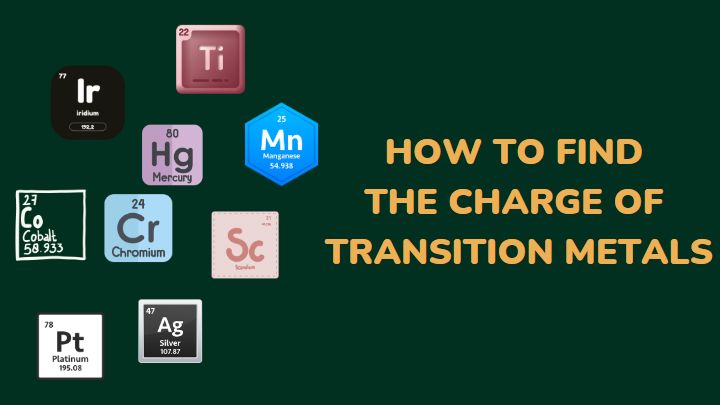How do you find the charge of transition metals?
Transition metals are the metals located in the d-block of the periodic table. Some of these metals include scandium, cobalt, zinc, silver, tungsten, gold, mercury, lead, radium, osmium, and platinum.
Transition metals are known for their high tendency of having more than one charge and oxidation state. As a result, determining the charge of transition metal may seem quite the task.
But, not to worry. I’ll be explaining how to can find the charge of transition metals. This article also includes a list of all transition metals and their charges.
Do transition metals form cations or anions?
All transition metals form cations. They are metals and will lose electrons to form positively charged ions. The charges on transition metals range from +1 to +4. In rare cases, they may have higher charges.
How can you find the charge of transition metals?
There are different ways to find the charge of transition metals. You can use any of the methods listed below:
The traditional method
Generally, the charge of an element is the difference between the number of protons and electrons in the atom of that element. If you know how many electrons the atom has lost, then, you can find the charge.
The number of protons and electrons of any atom in its neutral state is the same as its atomic number. But there is a difference between them when there is electron loss.
For instance, copper has an atomic number of 29. This means that there are 29 protons and 29 electrons. When it loses two electrons, the number of electrons drops to 27. A difference between the number of protons and electrons will give copper a +2 charge, Cu2+.
Using the total charges on a compound
If the metal is part of a compound, its charge will be equal to the difference between the total positive and negative charges of the other atoms or ions that make up the compound.
For example, find the charge of Cu in CuSO4. SO4 has a -2 charge.
Cu + (-2) = 0
Cu = +2
In a transition metal and anion combination
If the metal forms a compound with an anion, use this mathematical expression to find the charge of the transition metal.
Charge of transition metal + Charge of anion partner = Total charge of the compound
For instance, find the charge of Cu in CuBr2
Cu + 2(-1) = 0
Cu = +2
Finding the charge through the name of the compound
In instances where the name of the compound is provided, the Roman numeral provided in the brackets is the charge of the transition metal.
For instance,
In iron (II) oxide, iron (III) oxide, copper (II) chloride, and copper (II) nitrate, the charges are +2, +3, +2, and +2, respectively.
List of all transition metals and their charge

*Lutetium and lawrencium are not always considered transition metals.
Do all transition metals have multiple charges?
Not all transition metals have multiple charges. Silver (Ag+), zinc (Zn2+), and cadmium (Cd2+) have only one charge.
Do all transition metals have multiple oxidation states?
Yes. Multiple oxidation states are one of the unique characteristics of transition metals. This is due to their high tendency of losing electrons in their d-shells. It is much easier for transition metals to lose electrons than it is for alkali and alkaline-earth metals.
Furthermore, the (n-1)d orbitals of these elements are never filled up. This is why transition metals can easily accept more electrons in their (n-1)d orbitals. Moreover, these orbitals are closer to the outermost ns orbital in energy levels.
FAQs
Do transition metals have the same charge and valency?
Most transition metals have two electrons in their valence shell, which makes +2 the most common charge of transition metals.
A few exceptions such as silver have only one electron in their outermost shell which gives it a charge of +1.
Is the charge the same for all transition metals?
No, it is not. Unlike metals in groups 1 & 2, transition metals do not have the same charge. Some of these metals have one charge, while some have two charges.
Are there metalloids among the transition metals?
No. All transition metals are pure metals. Metalloids are elements on the periodic table that have both metallic and nonmetallic properties.
Furthermore, metalloids are located in the p-block and different groups of the periodic table. Some of these elements include germanium, arsenic, boron, carbon, silicon, antimony, selenium, tellurium, polonium, and astatine.
Conclusion
Transition metals are known for their unique characteristics. Their multiple charges are one of these characteristics.
One of the ways to find the charge of transition metals is to find the difference between the number of protons and electrons. You can also use any of the other methods listed in the article.
For easy retrieval, you can use the table in the article to know the charge of the different transition metals.
Read about the charge on the nucleus and the difference between nuclear charge and effective nuclear charge.
Thanks for reading.
